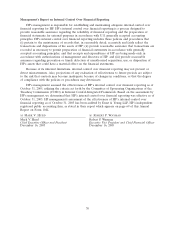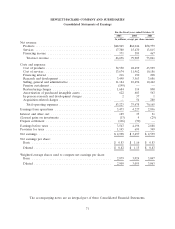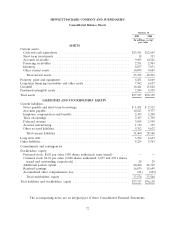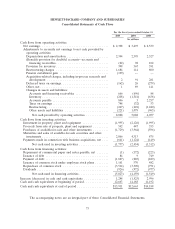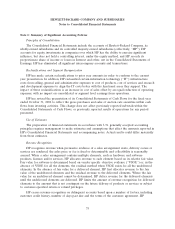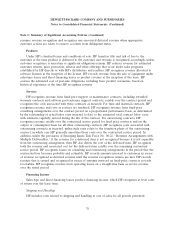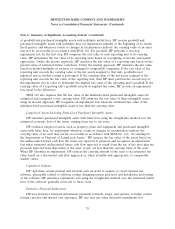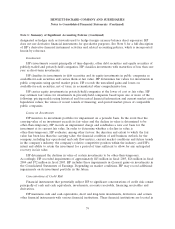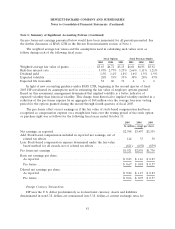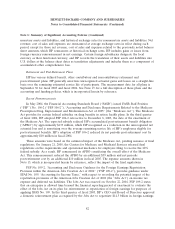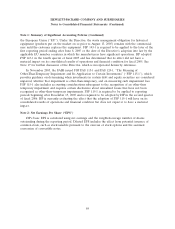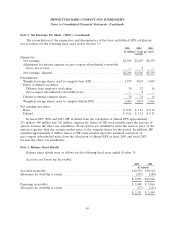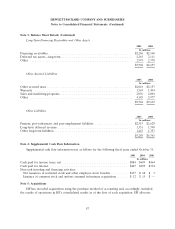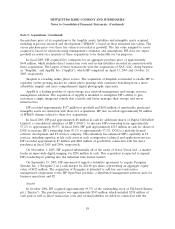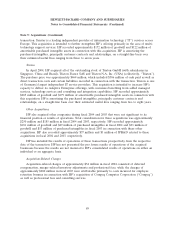HP 2005 Annual Report Download - page 84
Download and view the complete annual report
Please find page 84 of the 2005 HP annual report below. You can navigate through the pages in the report by either clicking on the pages listed below, or by using the keyword search tool below to find specific information within the annual report.HEWLETT-PACKARD COMPANY AND SUBSIDIARIES
Notes to Consolidated Financial Statements (Continued)
Note 1: Summary of Significant Accounting Policies (Continued)
many different geographical regions and HP’s policy is designed to limit exposure with any one
institution. As part of its cash and risk management processes, HP performs periodic evaluations of the
relative credit standing of the financial institutions. HP has not sustained material credit losses from
instruments held at financial institutions. HP utilizes forward contracts and other derivative contracts to
protect against the effects of foreign currency fluctuations. Such contracts involve the risk of
non-performance by the counterparty, which could result in a material loss.
HP sells a significant portion of its products through third-party distributors and resellers and, as a
result, maintains individually significant receivable balances with these parties. If the financial condition
or operations of these distributors and resellers deteriorate substantially, HP’s operating results could
be adversely affected. The ten largest distributor and reseller receivable balances collectively, which
were concentrated primarily in North America, represented approximately 22% of gross accounts
receivable at October 31, 2005 and 23% at October 31, 2004. No single customer accounts for more
than 10% of accounts receivable. Credit risk with respect to other accounts receivable and financing
receivables is generally diversified due to the large number of entities comprising HP’s customer base
and their dispersion across many different industries and geographical regions. HP performs ongoing
credit evaluations of the financial condition of its third-party distributors, resellers and other customers
and requires collateral, such as letters of credit and bank guarantees, in certain circumstances. HP
generally has experienced longer accounts receivable collection cycles in its emerging markets, in
particular Asia Pacific and Latin America, compared to its United States and European markets. In the
event that accounts receivable collection cycles in emerging markets significantly deteriorate or one or
more of HP’s larger resellers in these regions fail, HP’s operating results could be adversely affected.
Stock-Based Compensation
In fiscal 2005, HP applied the intrinsic-value-based method prescribed in Accounting Principles
Board (‘‘APB’’) Opinion No. 25, ‘‘Accounting for Stock Issued to Employees,’’ (‘‘APB 25’’) in
accounting for employee stock-based compensation. Accordingly, HP generally recognized
compensation expense only when it granted options with a discounted exercise price. HP recognized
any resulting compensation expense ratably over the associated service period, which was generally the
option vesting term.
In fiscal 2005, HP determined pro forma amounts as if the fair value method required by SFAS
No. 123, ‘‘Accounting for Stock-Based Compensation,’’ (‘‘SFAS 123’’) had been applied to its stock-
based compensation. The fair value of stock options and stock purchase rights were estimated on the
date of grant using the Black-Scholes option pricing model.
SFAS No. 123 (revised 2004), ‘‘Share-Based Payment’’ (‘‘SFAS 123R’’), clarifies the timing for
recognizing compensation expense for awards subject to acceleration of vesting on retirement. This
compensation expense must be recognized over the period from the date of grant to the date
retirement eligibility is met if it is shorter than the vesting term. Upon adoption of SFAS 123R, in the
first quarter of fiscal 2006, HP’s policy regarding the timing of expense recognition for employees
eligible for retirement will change to recognize compensation cost over the period from the grant date
through the date that the employee first becomes eligible to retire and is no longer required to provide
service to earn the award. During fiscal 2005, HP’s policy was to recognize these compensation costs
over the vesting term. Had HP applied non-substantive vesting provisions in SFAS 123R, the impact on
80


